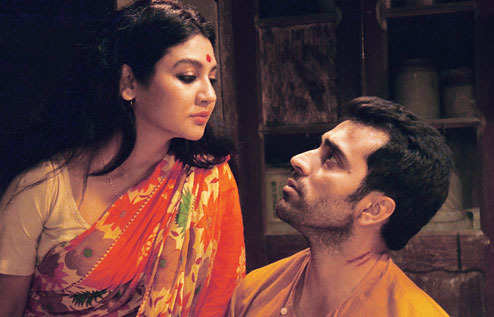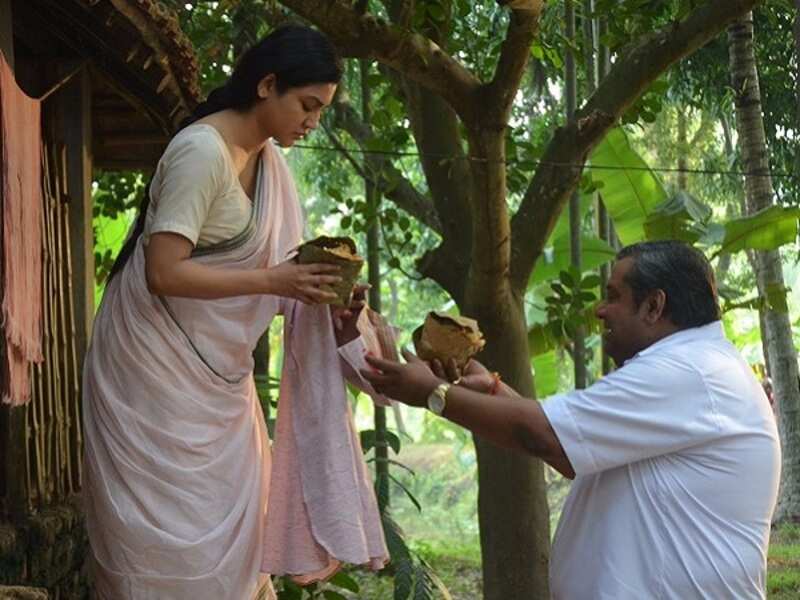The Bengali film Bishorjan is an interesting watch as it brings up the issue of agency of a woman who is on the margins owing to her class and her status as a widow. It also looks at intersections of religion, nationality and gender and how each of these determine the trajectory of the narrative. However, what is most fascinating about the film is that while it engages in an empathetic and very humanistic portrayal of its subaltern identities, it fails to problematise certain very deeply entrenched biases that are of a universal nature and in fact even goes as far as to make the audience empathise with those biases by promoting them.
Before we proceed to a more comprehensive and detailed reflection on these biases, a familiarisation with the storyline of Bishorjan is important. Padma (Jaya Ehsan) is a young widow in rural Bangladesh who lives with a physically and mentally incapacitated father-in-law. A rich, elderly bachelor Ganesh Mandal (Kaushik Ganguly) has eyes on her and wants to marry her. One day, Padma chances upon an unconscious young man lying in the swamp with the Indian flag on his person, along with the half immersed idol of Ma Durga and brings him home. She starts nursing the injured man and in due course, we come to know that the man is indeed an Indian and a Muslim. Padma fabricates a story to convince the villagers that he is her cousin who had come to visit her for a day but instead had a fall and was detained. She even gives him a Hindu name “Subhash” and addresses him as “Subhash da”.
Also read: How Dipangshu Acharya’s Case Exposes A Rot In Bengali Cinema
While Padma develops an affinity for Naser (Abir Chatterjee) alias Subhash, and even implies that he is a kind of surrogate husband for her by confessing that she is playing “doll’s house” with him, the latter is counting days to be able to get back to India and worried about his family and especially the woman he loves, back home. In Bishorjan, Padma not only tends to Naser and his wounds but also takes a huge risk by making phone calls to India to tell his family that he is safe and alive. We see Padma living her life under surveillance as she is followed by Ganesh Mandal’s sidekick who keeps informing his master of all her actions.
When Padma finally concedes to marry Ganesh in Bishorjan, she does it on her terms that he will ensure a safe passage for Naser to India which Ganesh does. When Ganesh marries Padma, he does so knowing fully well that she has been in a relation with Naser as he sees her dressed in a married woman’s attire with the symbolically smudged vermillion mark on her distraught face as she bids farewell to Naser. Of course, no viewer would want Padma to marry Ganesh and our heart breaks as we see Padma sitting inertly on a cart being escorted by Ganesh and his sidekick which has a strong resonance with Ma Durga’s immersion procession. This scene in Bishorjan suggests that though Padma is respected and adored like the “devi”, in the end she has no agency and now will have to marry Ganesh and live the rest of her life inertly. Her moment of immersion or “Visarjan” has taken place at the moment of parting with Naser.
Throughout the narrative of Bishorjan, there is a desperate hope for the underlying sexual/romantic tension between Padma and Naser to culminate which it eventually does, even though it is transgressive in many ways. This is the part in Bishorjan that is fascinating, as the only reason perhaps why Padma falls in love with an indifferent and preoccupied Naser and resists a lovelorn and devoted Ganesh, is because of the former’s good looks and the latter’s repulsive appearance.

Throughout the narrative of Bishorjan, there is a desperate hope for the underlying sexual/romantic tension between Padma and Naser to culminate which it eventually does, even though it is transgressive in many ways. This is the part in Bishorjan that is fascinating, as the only reason perhaps why Padma falls in love with an indifferent and preoccupied Naser and resists a lovelorn and devoted Ganesh, is because of the former’s good looks and the latter’s repulsive appearance.
One wonders, if the cast in Bishorjan were reversed, that is, if Kaushik Ganguly was cast to play Naser and Abir Chatterjee, Ganesh, could the story have progressed the way it did and would it have been a convincing narrative then? In other words, would Padma’s resistance to Ganesh and attraction for Naser have then made sense? We automatically sympathise with her and even with the idea that her marriage to Ganesh is akin to the devi’s immersion because he is much older than her but primarily because he is fat, dark, cross-eyed and in his own description “bad looking” which he unhesitatingly acknowledges while expressing his love for Padma and therefore is somehow also “naturally evil”. On the other hand, we desperately want the young, thin, good-looking and by default “naturally good” Naser to actually respond to Padma’s love and her advances and constant hinting, because the Padma-Naser duo of Bishorjan fits the normative picture of the ideal, onscreen, romantic, heterosexual couple.

The narrative facilitates viewer sympathy for Padma while clearly attempting to villainise Ganesh who is undeterred in his pursuit of her. What is strange however is that this pursuit of Ganesh is very easily pathologised because of his looks and it does take quite a bit of effort and unlearning to see Ganesh’s human side. Interestingly, Ganesh does what scores of men have done in scores of films before Bishorjan – gazing at Padma, calling on her uninvited, trying to imply how much he is committed to her, expressing his love and respect for her, proposing to her, and not giving up even when he senses very clearly that she is not the least bit interested in him. But if Kaushik Ganguly who plays Ganesh were to be replaced by say Shahrukh Khan for instance, it wouldn’t seem in the least bit offensive. In fact in films like Swades, Dilwale Dulhaniya Le Jaayenge, Deewana, Kuch Kuch Hota Hai and Kabhi Khushi Kabhi Gham, the characters Shahrukh Khan essays resort to archetypal Ganesh-like behaviour and yet these are films in which we see the heroine flying into the pursuer’s outstretched arms most willingly.
Also read: Parineeta Depicts The Progressive Facade Of The Bengali Bhadralok

Bishorjan thus fetishises good looks to a point where it becomes a deterrent in an otherwise very good narrative, and by projecting Ganesh as someone who uses his affluence and his authority in the village to coerce Padma into marrying him, obliterates his human side. Clearly, despite being single, rich and powerful, Ganesh is not a womaniser and is singularly devoted to Padma in Bishorjan. He even wears white in solidarity for she too wears only white being a widow. When her father-in-law dies, Ganesh organises his funeral ceremony and the “shraddha”; on Lakshmi puja, he comes with the idol of Lakshmi to Padma’s doorstep since he knows she will not come to his house. All of this seems explicit and repulsive and a lot of it, coercive tactics, and yet we know fully well, that if Ganesh were handsome, good-looking and thin, in other words, someone like Naser, he wouldn’t have had to go to such great lengths to get Padma’s approval and consent.
Bishorjan fetishises good looks to a point where it becomes a deterrent in an otherwise very good narrative, and by projecting Ganesh as someone who uses his affluence and his authority in the village to coerce Padma into marrying him, obliterates his human side.
Ganesh is projected in many ways, as someone innately evil, right in the exposition through his interaction with the local fisherman. He is the middleman who buys all the fish and makes huge profits by underpaying the fishermen. On the other hand, we have only Naser’s belated confession to Padma that he is a smuggler and he has been lying to her all along but we are more than willing to forget and forgive this side of his, just like Padma, who begs him to give up smuggling since it doesn’t “suit him”. Perhaps unethical activities do not suit good looking men, and is meant for only men like Ganesh.
With more and more films challenging stereotypes and established norms, we need more narratives that can dismantle such kind of a dangerous and regressive essentialism that equates physical appearance with character traits and reinforces and justifies colourism, fatphobia, ageism and ableism.
Featured image source: Observerbd.com
Very interesting. You’re right. A character played by SRK or Ranbir could easily get away with this very same behavior & wouldn’t be considered creepy.
An extremely good analysis. Also, why should her marrying Ganesh be seen as being immersed in water like visarjan of Durga as if it is a tragedy? Immersion of Durga is not abandonment of Durga but bidding farewell to her so she can come back next year. And, I am yet to see a film where a widow is shown ugly or unattractive. It is when they are beautiful that the audience sympathises with them.